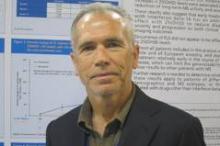DALLAS – Identifying and correcting low 25-hydroxyvitamin D levels early in the course of multiple sclerosis was associated with improved outcomes, results of a randomized study showed.
"In people who have had MS for many years, a low vitamin D level may be a consequence of the disease rather than a cause," Dr. Alberto Ascherio, a professor of epidemiology and nutrition at Harvard Medical School, Boston, said in an interview during the poster session at a meeting of the Consortium of Multiple Sclerosis Centers and the Americas Committee for Treatment and Research in Multiple Sclerosis.
"We looked at whether, at the first sign of a demyelinating attack, did the vitamin D level predict the long-term outcome of the disease?" Dr. Ascherio said.
Accordingly, in a randomized study, Dr. Ascherio and his colleagues found that patients with low vitamin D levels were found to have higher MS activity and more relapses with accelerated brain atrophy and neurodegeneration over a 5-year period, compared with patients whose vitamin D levels were higher.
In the study, 216 patients with clinically isolated syndrome (CIS) and two or fewer clinically silent brain lesions detected with imaging were randomly assigned to the early treatment arm. They received interferon beta-1b (Betaseron) 250 mcg subcutaneously every other day. The control arm of 118 patients, also with CIS and two or fewer clinically silent brain lesions received placebo treatment. The results of the study are published in JAMA Neurology (2014;71:306-14).
Serum levels of 25-hydroxyvitamin D [25(OH)D] were taken at baseline, and at 6, 12, and 24 months. The effects of 25(OH)D levels in patients assigned early treatment with interferon beta-1b were assessed by analyzing the vitamin’s serum concentration as a continuous variable at 20 ng/mL (50 nmol/L) increments, or as a dichotomous variable at levels less than 50 nmol/L vs. those of 50 nmol/L or greater.
Clinical and imaging follow-up was conducted on both treatment arms through 5 years.
Serum concentrations of 25(OH)D that increased by 20 ng/mL at 12 months resulted in a lower probability of conversion to MS (hazard ratio, 0.43; 95% confidence interval, 0.22-0.84; P = .01), and a lower trend toward conversion to clinically definite MS (HR, 0.48, 95% CI, 0.22-1.04; P = .06). The rate of newly active lesions was lower, with a rate ratio of 0.31 (95% CI, 0.15-0.61; P = .0008), and the rate ratio of relapse was 0.38 (95% CI, 0.14-0.99; P = .048).
With a 20 ng/mL change in [25(OH)D] in the first 12 months, the annual percentage change in T2 lesion volume was –26% (–39% to –12%; P = .0007), while the annual percent decline in brain volume was 0.64% (0.08% to 1.2%; P = .02).
The occurrence of flulike symptoms, commonly reported in interferon beta-1b treatment, was found not to differ according to 25(OH)D plasma levels in patients in the early treatment arm when tested at 6, 12, and 24 months.
Dr. Ascherio noted the findings were limited by the question of its generalizability, since nearly all patients were of white, of European descent, and had begun their treatment early. However, he concluded that the role of vitamin D in the course of the disease is now established and that, "it’s important to identify those patients with lower levels and correct their vitamin D deficiency early in the disease course."
This study was funded by Bayer. Dr. Ascherio said he has received honoraria from Almirall, Roche, Sanofi-Aventis, and Serono.
On Twitter @whitneymcknight

